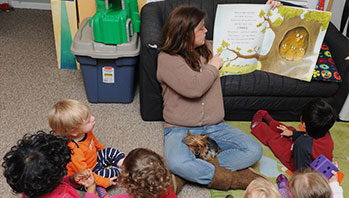- photocopies of the following illustrations from the book: the machine digging the hole, the workers putting up walls, the workers building the roof, the workers leaving
- builder
- building
- machine
- roof
- tool
MA Standards:
Reading for Informational Text: RI.P.MA.1 With prompting and support, ask and answer questions about an informational text read aloud.
Reading for Informational Text: RI.P.MA.2 With prompting and support, recall important facts from an informational text after hearing it read aloud.
Reading for Informational Text: RI.P.MA.3 With prompting and support, represent or act out concepts learned from hearing an informational text read aloud (e.g., make a skyscraper out of blocks after listening to a book about cities or, following a read-aloud on animals, show how an elephant’s gait differs from a bunny’s hop).
Head Start Outcomes:
Literacy Knowledge/Book Appreciation and Knowledge Asks and answers questions and makes comments about print materials.
PreK Learning Guidelines:
English Language Arts/Reading and Literature 6 Listen to a wide variety of age appropriate literature read aloud.
English Language Arts/Reading and Literature 10 Engage actively in read-aloud activities by asking questions, offering ideas, predicting or retelling important parts of a story or informational book.
Read Together: Building a House #1

© Commonwealth of Massachusetts, Department of Early Education and Care (Jennifer Waddell photographer). All rights reserved.
ELA Focus Skills: Listening and Speaking, Story Comprehension (Recall and Retell), Sequencing, Vocabulary
Before You Read
Tell children you are going to read a book about building a house. Say, But before I read, let’s take a look at the words on the cover. Do you see some letters you recognize? Do you see the letter "Bb" anywhere on the cover? Have children identify any letters they recognize and tell whether the letters are upper or lowercase.
Then review the different meanings for the word building.
- Show children the title page of the book. Say, Look at this house. What do you notice about the way it is shaped?
- Then look at the cover. Ask, What part of the house do you think the builders are building? What makes you think so?
- What tool is the man using? What do you think he is doing with it?
Set a reading focus for children by having them pay attention to what the builders do first, next, and last so that they can begin to understand how a house is built.
As You Read
Read slowly and with expression. Hold the book so everyone can see each two-page spread as you read. Pause and ask questions as you read.
- Pause on “a machine digs a big hole.” Ask, Why do you think the builders chose to use a machine instead of shovels to dig the hole?
- Pause on “Builders hammer and saw.” Ask, Why do you think the workers are using different tools? Can you describe each tool and how it makes their job easier?
- Pause on “An electrician wires for electric lights.” Say, This worker is called an electrician. What do you think would happen if the electrician did not do his work?
- Point to the ladder and say, Sometimes workers use a ladder to get their work done. What word do you know that would help us describe a ladder?
Use the illustrations and gestures to clarify the meaning of unfamiliar words such as bricklayers, carpenters, plumber, saw, pipes, electrician, etc.
After You Read
Ask children to tell you what the book was about—the main idea. Then tell children you have some pictures that show different parts of the house being built. Explain that you want them to help you put the pictures in order, or you want them to tell you what part of the house was done first, next, and last. Display the four pictures out of order. Ask,
- What step in building the house had to be done first, before any of these other steps could be done?
- Why do you think that has to be done first?
Have children place each picture in order and talk about why each step needs to be done in order as the house is being built.
English Language Learners: Give children more exposure to first, next, and last by reviewing the sequence of the illustrations with them one-on-one. To help children visualize sequence, go through the steps you take in completing a daily routine, such as reading the group a book. Hold up a book and say, First, I read the title and author. Next, I read the story. Last, I close the book and put it away. Ask children to tell you a daily routine they do in sequence (e.g., what they do before they go to bed, what they do before they eat breakfast, what they do when they arrive at school before morning meeting, etc.).
